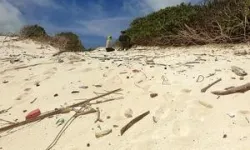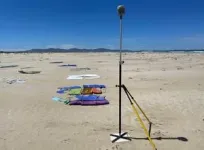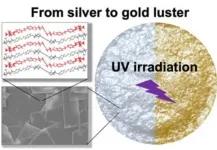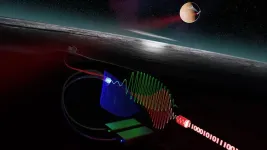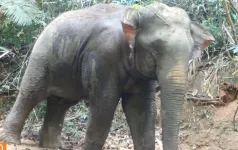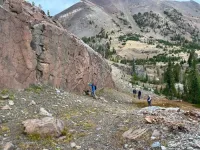(Press-News.org) Australian researchers have developed a new method for spotting plastic rubbish on our beaches and successfully field tested it on a remote stretch of coastline.
The satellite imagery tool developed by RMIT University scientists picks up differences in how sand, water and plastics reflect light, allowing plastics to be spotted on shorelines from more than 600km above.
Satellite technology is already used to track the massive amounts of plastic floating around our oceans – from relatively small drifts containing thousands of plastic bottles, bags and fishing nets, up to gigantic floating trash islands like the Great Pacific Garbage Patch, which is three times the size of France.
However, the satellite technology used to spot plastic floating in water doesn’t work so well in spotting plastic lying on beaches, where it can easily blend in with the sand.
This latest advance, published in the Marine Pollution Bulletin, means we now have an effective way to spot plastic on beaches, where it can be more easily accessed and removed by clean-up operations.
Oceans of plastic
We're currently sending well over 10 million tonnes of plastic trash into our oceans every year. It's estimated that by 2030 that figure could reach 60 million.
Study lead author, Dr Jenna Guffogg, said plastic on beaches can have severe impacts on wildlife and their habitats, just as it does in open waters.
“Plastics can be mistaken for food, larger animals become entangled and smaller ones, like hermit crabs, become trapped inside items such as plastic containers,” she said.
“Remote island beaches have some of the highest recorded densities of plastics in the world, and we’re also seeing increasing volumes of plastics and derelict fishing gear on the remote shorelines of northern Australia.”
Guffogg said if these plastics are not removed, they inevitably fragment further into micro and nano plastics.
“While the impacts of these ocean plastics on the environment, fishing and tourism are well documented, methods for measuring the exact scale of the issue or targeting clean-up operations, sometimes most needed in remote locations, have been held back by technological limitations,” she said.
How it works
The team’s Beached Plastic Debris Index is what’s known as a spectral index, essentially a mathematical formula that sorts patterns of reflected light collected by satellites as they pass over an area, to reveal what you’re most interested in seeing from the image.
The remote sensing team at RMIT have developed similar tools for monitoring forests and mapping bushfires from space.
The Beached Plastic Debris Index is tailored to mapping plastic debris in beach environments using high-definition data from the WorldView-3 satellite, which orbits the earth in line with the sun at an altitude of 617 km.
To test its performance, 14 plastic targets of around two square meters each were placed on a beach in southern Gippsland, Victoria.
Each target was made of a different type of plastic and was smaller than the satellite’s pixel size of about 3m2.
The satellite images using the new index were compared with three existing indices, two of which were designed for detecting plastics on land and one for detecting plastics in aquatic settings.
The BPDI outperformed all three, with the others either struggling to differentiate plastic-contaminated pixels on the beach or tending to mis-classify shadow and water as plastic.
Study co-author, Dr Mariela Soto-Berelov, said the enhanced separability of the BPDI against water, in addition to sand, suggests its utility is superior in environments where water pixels and plastic-contaminated pixels are likely to coexist.
“This is incredibly exciting, as up to now we have not had a tool for detecting plastics in coastal environments from space,” she said.
“The beauty of satellite imagery is that it can capture large and remote areas at regular intervals.
“Detection is a key step needed for understanding where plastic debris is accumulating and planning clean-up operations, which aligns with several Sustainable Development Goals, such as Protecting Seas and Oceans.”
Soto-Berelov said the next step is to test the BPDI’s utility in real life scenarios.
“We’re looking to partner with organisations on the next step of this research; this is a chance to help us protect delicate beaches from plastic waste,” she said.
Guffogg led this study as part of her joint PhD research at RMIT in Australia and University of Twente in the Netherlands, and now works in the geospatial mapping industry.
She was supported by an Australian Government Research Training Program (RTP) scholarship. The Worldview-3 imagery was accessed via DigitalGlobe, a US geospatial imagery vendor.
‘Beached Plastic Debris Index; A modern index for detecting plastics on beaches’ by Jenna Guffogg, Mariela Soto-Berelov, Chris Bellman, Simon Jones and Andrew Skidmore is published in Marine Pollution Bulletin, (DOI: 10.1016/j.marpolbul.2024.117124)
END
Scientists say plastic on beaches can now be seen from space
Australian researchers have developed a new method for spotting plastic rubbish on our beaches and successfully field tested it on a remote stretch of coastline
2024-10-30
ELSE PRESS RELEASES FROM THIS DATE:
New Starr Cancer Consortium grants awarded to Weill Cornell Medicine researchers
2024-10-30
Three teams led by Weill Cornell Medicine scientists have received awards from the Starr Cancer Consortium in its 17th and final annual grant competition. The grants will fund research on the deep mechanisms of common cancers and related treatment strategies.
The Starr Cancer Consortium, established in 2006 with generous support from The Starr Foundation, includes The Broad Institute of MIT and Harvard, Cold Spring Harbor Laboratory, Memorial Sloan Kettering Cancer Center, The Rockefeller University and Weill Cornell Medicine. The consortium’s goal has been to encourage highly collaborative and transformative research on cancer biology and novel treatment strategies. ...
Researchers aim to spark action to address rising homelessness among older people
2024-10-30
Homelessness among people over the age of 50 is on the rise, a phenomenon formal housing strategies often overlook -- but researchers from the University of Toronto and McGill hope to prevent this oversight in the future.
A new study published in The Gerontologist now provides a clear definition of late life homelessness informed by the lives and experiences of older adults. Drawing on interviews with older people who are unhoused and community workers in Montreal, Canada, the researchers aim to spark ...
Comparative metabolism of the humantenirine in liver microsomes from pigs, goats, and humans
2024-10-30
Background and objectives
Gelsemium elegans Benth (G. elegans) is a traditional medicinal plant; however, it is highly toxic, and toxicity varies significantly between species. The cause of this difference has not been clarified. Humantenirine is an important toxic alkaloid in G. elegans, and its metabolism has been poorly studied. This study aimed to compare the different metabolites formed by human liver microsomes, pig liver microsomes, and goat liver microsomes.
Methods
High-performance liquid chromatography/quadrupole time-of-flight mass spectrometry was used to study the metabolism of humantenirine in human liver microsomes, ...
Some wildfire suppressants contain heavy metals and could contaminate the environment
2024-10-30
In fire-prone areas, water isn’t the only thing used to quell blazes. Wildland firefighters also apply chemical or synthetic suppressants. Researchers reporting in ACS’ Environmental Science & Technology Letters explored whether these suppressants could be a source of elevated metal levels sometimes found in waterways after wildfires are extinguished. Several products they investigated contained high levels of at least one metal, including chromium and cadmium, and could contribute to post-fire increases in the environment.
“Wildfires ...
McMahon receives NIH grant to help build TTUHSC research capacity
2024-10-30
As a leader in academic health and biomedical research training, the Texas Tech University Health Sciences Center (TTUHSC) covers the West Texas region that comprises half of the state’s land mass and is home to 10% of its population. Research at TTUHSC drives innovation and discovery, changing the lives of those it serves and attracting talented faculty, staff and students.
During the latest reporting period (2020-2022), TTUHSC received an average of $12,539,679 annually in National Institutes ...
Turning silver to gold: A diacetylene derivative-based metallic luster materials
2024-10-30
Societies of the past and present have given high regard to precious metals like gold and silver. Both metals remind us of nobility and luxury. However, they are quite expensive, which restricts their applications. Therefore, materials with attractive but artificial gold- and silver-like metallic lusters are popular, finding use in jewelry, reflective materials, inks, and cosmetics.
Unfortunately, typical metallic luster materials cause environmental harm, rendering them unsustainable. Thus, scientists are actively searching for metal-free alternatives. In this direction, the research fraternity ...
Faster space communication with record-sensitive receiver
2024-10-30
In space exploration, long-distance optical links can now be used to transmit images, films and data from space probes to Earth using light. But in order for the signals to reach all the way and not be disturbed along the way, hypersensitive receivers and noise-free amplifiers are required. Now, researchers at Chalmers University of Technology, in Sweden, have created a system that, with a silent amplifier and record-sensitive receiver, paves the way for faster and improved space communication.
Space communication systems are increasingly based on optical laser beams rather than radio waves, as the signal loss has been shown to be less when light is used ...
New study shows that university students experienced increased psychological distress during COVID-19, but utilized fewer support services
2024-10-30
Embargoed Until 10/30/24 at 7 am
PhD in Public Health candidate Elaine Russell and her mentor Kenneth Griffin, professor in the department of Global and Community Health, in George Mason University’s College of Public Health, worked with Tolulope Abidogun, also a PhD in Public Health student, and former Global and Community Health professor Lisa Lindley, now of Lehigh University, to analyze data from the American College Health Association National College Health Assessment (ACHA-NCHA III) in an effort to understand how university ...
Camera trap study reveals a “vital sanctuary” for wildlife and endangered species in Cambodia’s Central Cardamom Mountains
2024-10-30
PHNOM PENH, Cambodia (October 30, 2024) – The first-ever camera trap study of the Central Cardamom Mountains Landscape has recorded 108 species, 23 of which are listed at risk (Vulnerable or above) on the IUCN Red List, underscoring the significance of the region as a global stronghold for biodiversity and rare and threatened species.
Editors please note: Use these links to access camera trap footage and the full report.
The report, released today by the Cambodian Ministry of Environment (MoE), the United States Agency ...
Buried Alive: Carbon dioxide release from magma deep beneath ancient volcanoes was a hidden driver of Earth’s past climate
2024-10-30
An international team of geoscientists led by a volcanologist at Rutgers University-New Brunswick has discovered that, contrary to present scientific understanding, ancient volcanoes continued to spew carbon dioxide into the atmosphere from deep within the Earth long past their period of eruptions.
In doing so, the research team has solved a long-standing mystery over what caused prolonged episodes of warming during turning points in Earth’s climate history. The work is detailed in today’s issue of the journal Nature Geoscience.
“Our ...
LAST 30 PRESS RELEASES:
Injectable breast ‘implant’ offers alternative to traditional surgeries
Neuroscientists devise formulas to measure multilingualism
New prostate cancer trial seeks to reduce toxicity without sacrificing efficacy
Geometry shapes life
A CRISPR screen reveals many previously unrecognized genes required for brain development and a new neurodevelopmental disorder
Hot flush treatment has anti-breast cancer activity, study finds
Securing AI systems against growing cybersecurity threats
Longest observation of an active solar region
Why nail-biting, procrastination and other self-sabotaging behaviors are rooted in survival instincts
Regional variations in mechanical properties of porcine leptomeninges
Artificial empathy in therapy and healthcare: advancements in interpersonal interaction technologies
Why some brains switch gears more efficiently than others
UVA’s Jundong Li wins ICDM’S 2025 Tao Li Award for data mining, machine learning
UVA’s low-power, high-performance computer power player Mircea Stan earns National Academy of Inventors fellowship
Not playing by the rules: USU researcher explores filamentous algae dynamics in rivers
Do our body clocks influence our risk of dementia?
Anthropologists offer new evidence of bipedalism in long-debated fossil discovery
Safer receipt paper from wood
Dosage-sensitive genes suggest no whole-genome duplications in ancestral angiosperm
First ancient human herpesvirus genomes document their deep history with humans
Why Some Bacteria Survive Antibiotics and How to Stop Them - New study reveals that bacteria can survive antibiotic treatment through two fundamentally different “shutdown modes”
UCLA study links scar healing to dangerous placenta condition
CHANGE-seq-BE finds off-target changes in the genome from base editors
The Journal of Nuclear Medicine Ahead-of-Print Tip Sheet: January 2, 2026
Delayed or absent first dose of measles, mumps, and rubella vaccination
Trends in US preterm birth rates by household income and race and ethnicity
Study identifies potential biomarker linked to progression and brain inflammation in multiple sclerosis
Many mothers in Norway do not show up for postnatal check-ups
Researchers want to find out why quick clay is so unstable
Superradiant spins show teamwork at the quantum scale
[Press-News.org] Scientists say plastic on beaches can now be seen from spaceAustralian researchers have developed a new method for spotting plastic rubbish on our beaches and successfully field tested it on a remote stretch of coastline

